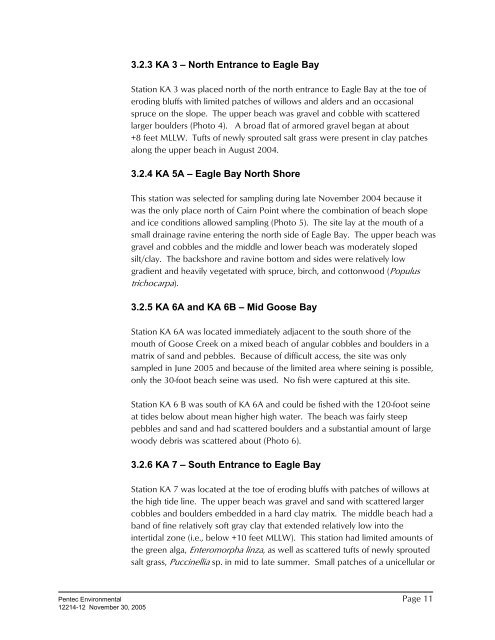Marine Fish and Benthos Studies - Knik Arm Bridge and Toll Authority
Marine Fish and Benthos Studies - Knik Arm Bridge and Toll Authority
Marine Fish and Benthos Studies - Knik Arm Bridge and Toll Authority
You also want an ePaper? Increase the reach of your titles
YUMPU automatically turns print PDFs into web optimized ePapers that Google loves.
3.2.3 KA 3 – North Entrance to Eagle Bay<br />
Station KA 3 was placed north of the north entrance to Eagle Bay at the toe of<br />
eroding bluffs with limited patches of willows <strong>and</strong> alders <strong>and</strong> an occasional<br />
spruce on the slope. The upper beach was gravel <strong>and</strong> cobble with scattered<br />
larger boulders (Photo 4). A broad flat of armored gravel began at about<br />
+8 feet MLLW. Tufts of newly sprouted salt grass were present in clay patches<br />
along the upper beach in August 2004.<br />
3.2.4 KA 5A – Eagle Bay North Shore<br />
This station was selected for sampling during late November 2004 because it<br />
was the only place north of Cairn Point where the combination of beach slope<br />
<strong>and</strong> ice conditions allowed sampling (Photo 5). The site lay at the mouth of a<br />
small drainage ravine entering the north side of Eagle Bay. The upper beach was<br />
gravel <strong>and</strong> cobbles <strong>and</strong> the middle <strong>and</strong> lower beach was moderately sloped<br />
silt/clay. The backshore <strong>and</strong> ravine bottom <strong>and</strong> sides were relatively low<br />
gradient <strong>and</strong> heavily vegetated with spruce, birch, <strong>and</strong> cottonwood (Populus<br />
trichocarpa).<br />
3.2.5 KA 6A <strong>and</strong> KA 6B – Mid Goose Bay<br />
Station KA 6A was located immediately adjacent to the south shore of the<br />
mouth of Goose Creek on a mixed beach of angular cobbles <strong>and</strong> boulders in a<br />
matrix of s<strong>and</strong> <strong>and</strong> pebbles. Because of difficult access, the site was only<br />
sampled in June 2005 <strong>and</strong> because of the limited area where seining is possible,<br />
only the 30-foot beach seine was used. No fish were captured at this site.<br />
Station KA 6 B was south of KA 6A <strong>and</strong> could be fished with the 120-foot seine<br />
at tides below about mean higher high water. The beach was fairly steep<br />
pebbles <strong>and</strong> s<strong>and</strong> <strong>and</strong> had scattered boulders <strong>and</strong> a substantial amount of large<br />
woody debris was scattered about (Photo 6).<br />
3.2.6 KA 7 – South Entrance to Eagle Bay<br />
Station KA 7 was located at the toe of eroding bluffs with patches of willows at<br />
the high tide line. The upper beach was gravel <strong>and</strong> s<strong>and</strong> with scattered larger<br />
cobbles <strong>and</strong> boulders embedded in a hard clay matrix. The middle beach had a<br />
b<strong>and</strong> of fine relatively soft gray clay that extended relatively low into the<br />
intertidal zone (i.e., below +10 feet MLLW). This station had limited amounts of<br />
the green alga, Enteromorpha linza, as well as scattered tufts of newly sprouted<br />
salt grass, Puccinellia sp. in mid to late summer. Small patches of a unicellular or<br />
Pentec Environmental Page 11<br />
12214-12 November 30, 2005
















